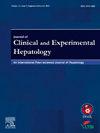Long-term Prognosis in Pediatric Living Donor Liver Transplant Recipients Who Have Survived the First Year of Surgery
IF 3.3
Q2 GASTROENTEROLOGY & HEPATOLOGY
Journal of Clinical and Experimental Hepatology
Pub Date : 2025-06-24
DOI:10.1016/j.jceh.2025.102631
引用次数: 0
Abstract
Background
Understanding long-term pediatric living donor liver transplant (LDLT) outcomes is crucial for families when consenting to it. This study focussed on pre-liver transplant (LT) clinical parameters, surgical procedures, delayed complications, follow-up challenges, and long-term prognosis within a living-donor program in a developing country.
Methods
This single-center retrospective study was carried out using a prospectively maintained database spanning from September 2006 to January 2023. The study included all pediatric LT (pLT) recipients, aged 1 month to 17 years, who survived for more than a year following LT.
Results
During the study, 480 pLTs were performed, with 448 (93.3%) children surviving beyond one year. Of 448 pLT recipients, 358 with adequate follow-up data formed the study cohort for long-term outcomes, while 90 with poor medication adherence and/or insufficient follow-up were analyzed separately as a noncompliant group. The majority (232,65%) of patients supplemented physical outpatient visits with online follow-up consultations via email and other online platforms. Twenty-three percent necessitated intervention within three-months of the surgery; however, it had no impact on occurrence of late complications or overall survival (P = 0.398). The primary cause of noncompliance was socioeconomic factors, which contributed to an increased incidence of chronic rejection in this group (12/90, 13.3%). Out of 358 compliant children, 30 died and 23 survived following late radiological or surgical intervention, while the remaining 305 had an uneventful long-term course with a median follow-up of 62 (IQR:31–112) months. The life table showed survival probabilities of 95%, 93%, 91%, and 72.4% at 3, 5, 10, and 15 years, respectively. Pediatric end-stage liver disease (PELD) score and post-LT portal vein thrombosis (PVT) were independent prognostic factors for long-term survival.
Conclusion
Pediatric LDLT yields favorable long-term outcomes, especially in 1-year survivors. Online follow-ups are beneficial in developing countries. Pre-LT PELD score and post-LT PVT help assess risk and optimize care.

存活一年后的儿童活体肝移植受者的长期预后
背景:了解儿童活体肝移植(LDLT)的长期预后对家庭是否同意这项手术至关重要。本研究的重点是在一个发展中国家的活体供体项目中,肝移植前(LT)的临床参数、外科手术、延迟并发症、随访挑战和长期预后。方法本研究采用前瞻性数据库,时间跨度为2006年9月至2023年1月。该研究纳入了所有儿童LT (pLT)接受者,年龄在1个月至17岁之间,在LT后存活超过一年。结果在研究期间,进行了480例pLT,其中448例(93.3%)儿童存活超过一年。在448名pLT接受者中,358名随访数据充足的人组成了长期结果的研究队列,而90名药物依从性差和/或随访不足的人被单独分析为不依从组。大多数(232,65%)患者通过电子邮件和其他在线平台进行在线随访咨询,以补充物理门诊就诊。23%的人需要在手术后三个月内进行干预;但对晚期并发症的发生及总生存期无影响(P = 0.398)。不遵医嘱的主要原因是社会经济因素,这导致该组慢性排斥发生率增加(12/90,13.3%)。在358名依从的儿童中,30人死亡,23人在后期放射或手术干预后存活,而其余305人有一个平稳的长期过程,中位随访时间为62个月(IQR: 31-112)。生命表显示,3年、5年、10年和15年的生存率分别为95%、93%、91%和72.4%。儿童终末期肝病(PELD)评分和lt后门静脉血栓形成(PVT)是影响长期生存的独立预后因素。结论:儿童LDLT具有良好的长期预后,特别是对于1年存活者。在线跟进在发展中国家是有益的。lt前PVT评分和lt后PVT评分有助于评估风险和优化护理。
本文章由计算机程序翻译,如有差异,请以英文原文为准。
求助全文
约1分钟内获得全文
求助全文
来源期刊

Journal of Clinical and Experimental Hepatology
GASTROENTEROLOGY & HEPATOLOGY-
CiteScore
4.90
自引率
16.70%
发文量
537
审稿时长
64 days
 求助内容:
求助内容: 应助结果提醒方式:
应助结果提醒方式:


